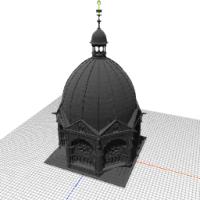Dome of New Synagogue in Wroclaw (1872) by Sima Agajew [OBJ]

Crried out by der institute of architecture the project “When You Synagogue in the context of the three religious communities digital Reconstruction and Documentation of the Breslau/Wroclaw Synagogue” offers a unique opportunity to explore this amazing temple and unique focal point in the city's skyline.
The project provides for a semantically saturated digital model of the synagogue that harnesses new research methodology using the virtual research environments (Virtuelle Forschungsumgebung, VFU). VRE enables the scientific analysis of the sources used for the reconstruction of the building and the development of links connecting different sets of data namely corporate bodies, persons, objects, sources, historical events, research activities, and places. The model also elaborates Breslau’s special context in circa 1872, when the synagogue opened; it is also embedded in the social and cultural context of that time most notably in religious matters. For the purpose, an extended database was developed to provide information in evangelical and Catholic communities in the city, and two respective churches they all almost concurrently developed: send salvatore's church and Saint Michael's church, which together with the new synagogue we're expected to act as vertical landmarks in Breslow cityscape. The project also advances new methodology for the digital reconstruction of historic architecture which provides for an innovative recontextualization of perished cultural heritage using vibrant and thriving digital humanities.
The project also involved a Polish-German workshop for architecture students from the Hochschule Mainz, Germany, and art history students from the university of Wroclaw, Poland. The workshop was focused on 19th century sacred architecture in Breslau and explored five designs for Saint Salvatore’s church by C.J. Ch. Zimmerman (1831-1911), neither of which ever went beyond the conceptual stage. The project also involved a Polish-German workshop for architecture students from the Hochschule Mainz, Germany, and art history students from the university of Wroclaw, Poland. The workshop was focused on 19th century sacred architecture in Breslau and explored five designs for Saint Salvator 's church by C.J.Ch. Zimmermann (1831-1911) none of which ever went beyond the conceptual stage.
The nine night of 9th November 1938 witnessed the most harrowing pogrom of German Jewry since the Middle Ages. Synagogues and other Jewish property were desecrated and destroyed, including each and every synagogue designed by Edwin Oppler. November 2018 marked the 80th anniversary of these events, which we commemorate with an AR (augmented Reality) app. Specially designed for the purpose, it visualizes the perished new synagogue in Breslau. The app comes with a dedicated synagogue postcard, which we premiered during the annual March of Mutual Respect, commemorating the pogrom and covering the route from the White Stork synagogue to where the New Synagogue used to be located. The citizens of today's Wroclaw join the march as a living testimony to the new harrowing events, which also served as a prelude to the holocaust.
As such, the digital reconstruction project preserves memory and raises the awareness of Breslau‘s Jewish Community and its complex history, a history that straddles two countries in time: pre-war Germany and today‘s Poland.
Carried out by the Institute of Architecture, Hochschule Mainz, the project "The New Synagogue in the context of Three Religious Communities. Digital Reconstruction and Documentation of the Breslau/Wroclaw Synagogue"
and so on and so on....in